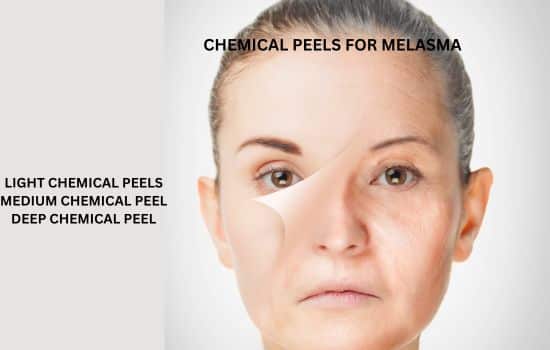Best Chemical Peels For Melasma-Understanding the Types And Effectiveness:
Melasma is a notorious skin condition and is resistant to treatment. There are many treatment plans for melasma, including the chemical peel. This procedure destroys the epidermis, the outer skin layer, and as a result natural healing process starts and regenerates a new epidermis with less pigmentation. This blog will explore which chemical melasma peels are used for treatment.
Highlights
Toggle
Best Professional Chemical Peel For Melasma-What’s In:
There are different forms of chemical peels, and they have extra strength and applications. Melasma chemical peels have proven results, they work by preventing melanin pigment production in the skin. Which may also reduce hyperpigmentation.
Moreover, it is an effective process, and it also prevents the reoccurrence of melasma; the various forms of chemicals used in peels are

– Tretinoin
– Salicylic acid
Trichloroacetic acid
-Jessner’s solution
– Glycolic acid
1- Tretinoin:
Tretinoin peel has the exact mechanism of action as topical tretinoin works for melasma. This peel is less popular than other peels used to treat melasma. However, it is beneficial compared to other peels because it is well tolerated and has fewer side effects. It does not bleach the skin directly; instead, it promotes cell turnover and enhances the effectiveness of other medicines.
2- Salicylic acid:
Salicylic acid is an effective and superficial chemical peel for melasma. It helps to treat mild to moderate melasma. It is beta hydroxy acid and exfoliates the skin surface and reduces pigmentation.
3- Trichloroacetic Acid:
The most common peel for melasma is TCA (trichloroacetic acid). TCA penetrates deep into the skin due to that it has some side effects compared to the other peels. This peel is helpful for severe melasma due to its penetration power. Moreover, this peel is used for patients that have lighter skin tones.
4- Jessner’s Peels:
In jessners peels, alpha hydroxy acids, salicylic acid, lactic acid, and resorcinol)are present in its solution. Due to the combination of three acids, doctor uses this peel for severe melasma. It helps the skin by breaking up damaged skin and promoting cell turnover. There is no one treatment option for melasma. Your dermatologist will choose the best treatment for you according to your skin tone.
5- Glycolic acid:
The most common chemical peel treatment for melasma is the glycolic acid peel. Glycolic acid is an organic compound derived from the natural product sugar cane. It is also a superficial peel used to treat mild to moderate melasma. It removes dead skin cells, resulting in a new epidermis and reducing melasma.
According to the study, Glycolic peels are tolerable, most effective, and safe to treat acne type 1.
Chemical Peels: Mode of Action:
It is exciting how chemical peels work to reduce melasma. Chemical peels contain acids that bind with the skin cells, remove the dead skin, and exfoliate. These peels are topical masks that peel the skin gently.
Due to peeling, the skin’s healing process starts, leading to collagen formation and decreasing the melanin in the pigmented areas from the outer layer of the skin.

Steps For Getting Chemical Peels:
The procedure of chemical peel is very simple and needs a few sessions to treat skin conditions. It includes the following step.
1- Cleansing:
The first is cleansing the skin to remove dirt, excess oil, and sebum.
2- Application Of Peeling Agent:
The next step is the application of a peeling mask for several minutes, depending upon which peeling agent is applied and the severity of the melasma.
After application of the mask, you will feel a burning sensation, and it’s a typical indication that the mask is working.
3- Neutralization:
The peeling agent is neutralized after a few minutes.
Remember, your skin can have slight redness and inflammation after superficial peeling.
In contrast, other peels penetrating the skin cause severe inflammation. These symptoms persist for weeks until a new epidermis forms.
FAQS:
1. Is there a possibility of a reoccurrence of melasma after the chemical peel?
Yes, it is possible that melasma can come back after a chemical peel. It can return when you don’t protect your skin from harmful UV rays.
2. Which type of sunscreen should we use for melasma prevention?
Before going outside, you should use sunscreens that contain oxybenzone, zinc oxide, and titanium dioxide. These contents transform and reflect the sun’s rays.
3. Are chemical peels effective for melasma?
Yes, chemical peels are effective for melasma prevention and elimination.
Finally:
Chemical peels are an effective treatment for melasma. You should consult an experienced dermatologist for this treatment because your healthcare professional will decide which peel suits you according to your skin tone. Moreover, people with darker skin tones are at a high risk of post-inflammation after chemical peels.
Rerefrence:
https://www.ncbi.nlm.nih.gov/pmc/articles/PMC5724304/
https://www.ncbi.nlm.nih.gov/pmc/articles/PMC3560164/
https://www.ncbi.nlm.nih.gov/pmc/articles/PMC4362567/


Very helpful